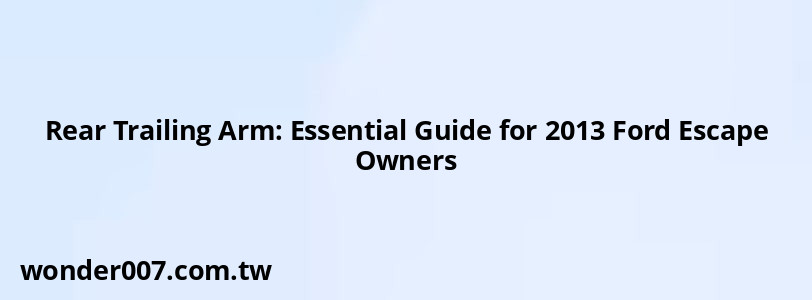Rear Trailing Arm: Essential Guide for 2013 Ford Escape Owners

The rear trailing arm is a critical component of the suspension system in the 2013 Ford Escape. Understanding its function, signs of wear, and replacement procedures can help ensure your vehicle operates safely and efficiently.
What is the Rear Trailing Arm?
The rear trailing arm connects the rear axle to the vehicle's body, allowing for vertical movement of the suspension while maintaining wheel alignment. This component is essential for a smooth ride and proper handling.
Symptoms of a Worn Rear Trailing Arm
As the trailing arm and its bushings wear out, drivers may experience several noticeable symptoms:
- Clunking or Thumping Noises: These sounds often indicate worn bushings or a failing trailing arm.
- Instability While Driving: A vehicle may feel unstable, especially during turns, due to improper alignment caused by a damaged trailing arm.
- Uneven Tire Wear: Worn bushings can lead to alignment issues, resulting in uneven tire wear.
- Death Wobble: This term describes a severe shaking of the steering wheel when driving, often caused by suspension issues including trailing arm problems.
Recognizing these symptoms early can prevent further damage and costly repairs.
Replacement Process
Replacing the rear trailing arm or its bushings is a task that can be done with some mechanical knowledge. Here are the general steps involved:
1. Lift the Vehicle: Use a floor jack to raise the rear of the vehicle and secure it with jack stands.
2. Remove Wheels: Take off the rear wheels for better access to the suspension components.
3. Disconnect Components: Remove any necessary components that obstruct access to the trailing arm, including brake lines or sensors.
4. Remove Old Trailing Arm: Unbolt the old trailing arm from both ends and carefully take it out.
5. Install New Trailing Arm/Bushings: Position the new trailing arm in place and secure it with bolts. Ensure all connections are tight and properly aligned.
6. Reassemble Components: Reattach any components that were removed earlier, ensuring everything is secured.
7. Test Drive: After reassembly, take the vehicle for a test drive to ensure proper handling and noise levels.
It's recommended to consult your vehicle's service manual for specific torque specifications and detailed instructions.
FAQs About Rear Trailing Arms
FAQs About Rear Trailing Arm
- How often should I check my trailing arm?
It’s advisable to inspect your trailing arms during regular maintenance checks, especially if you notice any symptoms of wear. - Can I drive with a worn trailing arm?
While it may not be immediately dangerous, driving with a worn trailing arm can lead to further damage and should be addressed promptly. - What tools do I need for replacement?
You will typically need basic hand tools such as wrenches, sockets, and possibly a press for bushing replacement.
Understanding the role of the rear trailing arm in your 2013 Ford Escape is crucial for maintaining vehicle safety and performance. Regular inspections and prompt repairs will help ensure your vehicle remains reliable on the road.
Related Posts
-
Cat Forklift Warning Lights: Safety Guide
26-01-2025 • 143 views -
2015 Hyundai Sonata Key Fob Programming Guide
28-01-2025 • 159 views -
BMW 740i Catalytic Converter Scrap Price Guide
26-01-2025 • 152 views -
Side Mirror Glass Replacement: A Complete Guide for Your 2013 Kia Optima
29-01-2025 • 229 views -
Control Module Power Circuit: Design Essentials
26-01-2025 • 169 views
Latest Posts
-
Rear Brake Caliper Piston Won't Compress
01-02-2025 • 315 views -
Power Steering Fluid Leak On Passenger Side
01-02-2025 • 420 views -
2015 Chevy Traverse AC Recharge Port Location
01-02-2025 • 366 views -
How To Turn Off Paddle Shifters Mercedes
01-02-2025 • 335 views -
Are O2 Sensors Covered Under Warranty
01-02-2025 • 339 views
Popular Posts
-
V12 Engine Costs: What You Need to Know
26-01-2025 • 633 views -
Hino Warning Lights: Understanding Dashboard Alerts
26-01-2025 • 635 views -
EPC Light: Understanding Causes and Solutions
26-01-2025 • 1019 views -
Power Steering and ABS Light On: Causes and Solutions
27-01-2025 • 613 views -
EPC Warning Light: What It Means for Your Vehicle
27-01-2025 • 591 views
